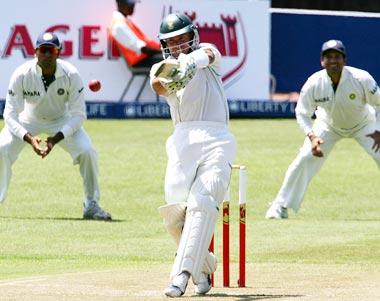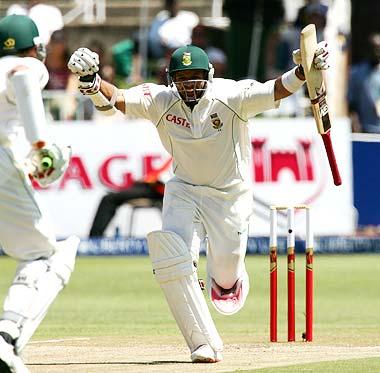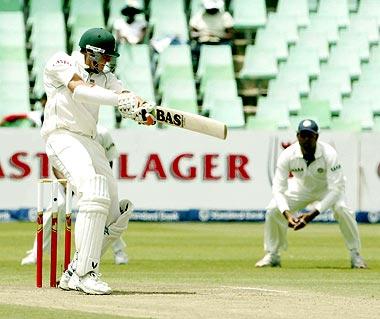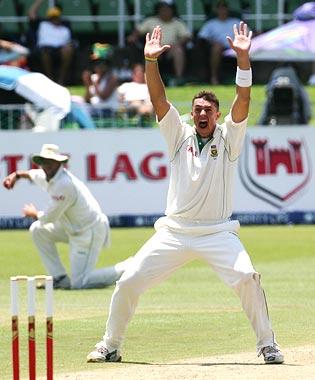1st Test: Day 1 India Vs South Africa
December 15, 2006
South Africa fast bowler Makhaya Ntini celebrates after getting the wicket of India opener Wasim Jaffer on day one of the first Test at the Wanderers Stadium in Johannesburg, on Friday.
Ntini struck early when Jaffer offered no stroke and was trapped leg before wicket for 9.
India, who won the toss and elected to bat, included VRV Singh ahead of Irfan Pathan while Harabhajan Singh was left out.

Dravid is hit on the chest by a short delivery from Shaun Pollock.
India lost both their openers quite early as Dravid and Sachin Tendulkar looked to steady things.
Earlier, damp spots on the pitch had delayed the start of the match by 90 minutes.

Tendulkar, though circumspect, worked the ball through the leg-side and kept the scoreboard ticking.
His innings was a good mix of caution and aggression as he scored 44 at a brisk rate before he was caught in the slips off Jacques Kallis.
Dravid was unbeaten on 30 from 73 balls and VVS Laxman on one as India recovered to 101 for three at tea on the opening day.
 VVS Laxman played a positive innings of 28, punctuated by five boundaries, to steady the ship after Dravid's wicket.
VVS Laxman played a positive innings of 28, punctuated by five boundaries, to steady the ship after Dravid's wicket.
Laxman, who has involved in a 46-run partnership for the fifth wicket with Sourav Ganguly, was out caught behind off Makhaya Ntini late in the day.

Coming back into the Test team after 10 months, Ganguly battled with determination against the South African pace attack.
Though the former captain was beaten on a number of occassions, he hung in there and was unbeaten on 14 at the close of play as India reached 156 for 5.
1st Test: Day 2
Zaheer, Sreesanth give India hope
India's pacemen gave the team a rousing start, reducing South Africa to 21 for three at lunch on the second day of the first Test at the Wanderers, on Saturday.
S Sreesanth and Zaheer Khan bowled with great intensity and discipline to scythe through the South African top order and bowl India right back into the game, after the visitors were dismissed for 249 in the morning. Sreesanth picked the wickets of Graeme Smith and Hashim Amla while Zaheer sent Herschelle Gibbs back.
Sourav Ganguly signalled his return to international cricket with an unbeaten half-century, the only of the Indian innings, even as the Indian lower order collapsed without a fight after the visitors resumed on 156 for five on the second morning.
Last-man VRV Singh's entertaining knock of 29 gave the Indian total a much-needed boost, and added 44 runs for the last wicket with Ganguly.
Shaun Pollock narrowly missed out on completing 400 Test wickets, as he finished with figures of four for 39, one short of the milestone.
Makhaya Ntini grabbed three for 57 while Andre Nel also added to his wickets tally, claiming the wicket of Anil Kumble.
Morning session
The Indian batsmen had an edgy start in the morning, with Kallis hitting the right length straightaway and Nel nailing them with pace and bounce.
But it was still Shaun Pollock who gave the hosts their moment of the morning.
The veteran player showed amazing commitment, diving full length and plucking the ball with his left hand to complete a catch and send back Mahendra Singh Dhoni for five.
Dhoni failed to keep the drive off Makhaya Ntini down before Pollock intercepted it.
Sourav Ganguly, who had faced the South African pace battery staunchly on Friday, once again survived the opening spell from Andre Nel and Makhaya Ntini in overcast conditions. Though Nel lacked the consistency, coming round the wicket to Ganguly, he made the ball move both ways to pose ample problems.
The left-hander, however, shrugged off the close calls and went after the loose deliveries. He picked Ntini from good length with minimal foot movement and sent the ball into the stands for India's first six of the innings.
Anil Kumble tried to battle it out in the middle but the relentless South African bowling got the better of him. After surviving a difficult dropped chance by Herschelle Gibbs in slips, Kumble once again left his bat hanging to Nel. He couldn't get his bat out of the way as the ball shaped in and took a thick edge to Jacques Kallis at second slip.
Ganguly guided India past 200, but there wasn't much to the lower order.
Zaheer Khan (9) was trapped leg before wicket by Pollock as the batsman went down on one knee in an attempt to sweep. Zaheer missed the ball completely and it hit him full on middle and leg stump. Sreesanth followed two balls later for no score.
VRV Singh then breathed some excitement into the dreary morning. The young Punjab lad threw his bat around, stood outside the leg stump and, with exaggerated foot movement, added on some vital runs on the board. He lived dangerously, and his edges seemed to inevitably land between fielders.
The 22-year-old's antics left the bowlers bemused, and Graeme Smith was forced to spread his field for the first time in the Indian innings. VRV motored along to 29 from 19 balls, with the help of six fours, to add a positive footnote to the Indian effort.
Meanwhile, Ganguly carved out a well-deserved half-century. The 33-year-old worked the ball to the leg-side for a single to bring up his 26th Test fifty. He was unbeaten on 51 from 101 balls when Pollock finally brought VRV's adventure to an end with a slower ball.
Ganguly and VRV Singh slammed 44 runs in 5.5 overs for the last wicket to swell the Indian total to 249.
South Africa innings
India's new-ball bowlers gave the team a rousing start, snapping the South African openers inside three overs.
Sreesanth set the ball rolling with the wicket of skipper Smith. Pitching the ball just short of length, he got the ball to move in and strike the pads to trap Smith leg before wicket.
With the pitch juicing up under an overcast sky, Sreesanth and Zaheer Khan got the new ball to swing and, more importantly, forced the batsmen into false shots. The Indian bowlers, who had got early wickets even in the One-day series, used the conditions better than the home bowlers to raise India's hopes of a great comeback.
Zaheer had Herschelle Gibbs flashing at a slightly wide delivery, with Virender Sehwag taking the catch at gully while Sreesanth lured Amla into a drive, the edge carrying to VVS Laxman in the slips.
India were denied a huge scalp, when umpire Daryl Harper turned down a confident shout for lbw against Jacques Kallis.
Zaheer got the ball to straighten from middle and off and hit the back leg plumb in front of the stumps, but the umpire ruled in favour of the batsmen.
As if rubbing insult to injury, Kallis followed it up with two elegant drives for four.
Kallis and Ashwell Prince were unbeaten on 12 and one respectively, as South Africa recovered from five for three to 21 for three.
South Africa All Out for 84
December 15, 2006
South Africa fast bowler Makhaya Ntini celebrates after getting the wicket of India opener Wasim Jaffer on day one of the first Test at the Wanderers Stadium in Johannesburg, on Friday.
Ntini struck early when Jaffer offered no stroke and was trapped leg before wicket for 9.
India, who won the toss and elected to bat, included VRV Singh ahead of Irfan Pathan while Harabhajan Singh was left out.

Dravid is hit on the chest by a short delivery from Shaun Pollock.
India lost both their openers quite early as Dravid and Sachin Tendulkar looked to steady things.
Earlier, damp spots on the pitch had delayed the start of the match by 90 minutes.

Tendulkar, though circumspect, worked the ball through the leg-side and kept the scoreboard ticking.
His innings was a good mix of caution and aggression as he scored 44 at a brisk rate before he was caught in the slips off Jacques Kallis.
Dravid was unbeaten on 30 from 73 balls and VVS Laxman on one as India recovered to 101 for three at tea on the opening day.

Laxman, who has involved in a 46-run partnership for the fifth wicket with Sourav Ganguly, was out caught behind off Makhaya Ntini late in the day.

Coming back into the Test team after 10 months, Ganguly battled with determination against the South African pace attack.
Though the former captain was beaten on a number of occassions, he hung in there and was unbeaten on 14 at the close of play as India reached 156 for 5.
1st Test: Day 2
Zaheer, Sreesanth give India hope
India's pacemen gave the team a rousing start, reducing South Africa to 21 for three at lunch on the second day of the first Test at the Wanderers, on Saturday.
S Sreesanth and Zaheer Khan bowled with great intensity and discipline to scythe through the South African top order and bowl India right back into the game, after the visitors were dismissed for 249 in the morning. Sreesanth picked the wickets of Graeme Smith and Hashim Amla while Zaheer sent Herschelle Gibbs back.
Sourav Ganguly signalled his return to international cricket with an unbeaten half-century, the only of the Indian innings, even as the Indian lower order collapsed without a fight after the visitors resumed on 156 for five on the second morning.
Last-man VRV Singh's entertaining knock of 29 gave the Indian total a much-needed boost, and added 44 runs for the last wicket with Ganguly.
Shaun Pollock narrowly missed out on completing 400 Test wickets, as he finished with figures of four for 39, one short of the milestone.
Makhaya Ntini grabbed three for 57 while Andre Nel also added to his wickets tally, claiming the wicket of Anil Kumble.
Morning session
The Indian batsmen had an edgy start in the morning, with Kallis hitting the right length straightaway and Nel nailing them with pace and bounce.
But it was still Shaun Pollock who gave the hosts their moment of the morning.
The veteran player showed amazing commitment, diving full length and plucking the ball with his left hand to complete a catch and send back Mahendra Singh Dhoni for five.
Dhoni failed to keep the drive off Makhaya Ntini down before Pollock intercepted it.
Sourav Ganguly, who had faced the South African pace battery staunchly on Friday, once again survived the opening spell from Andre Nel and Makhaya Ntini in overcast conditions. Though Nel lacked the consistency, coming round the wicket to Ganguly, he made the ball move both ways to pose ample problems.
The left-hander, however, shrugged off the close calls and went after the loose deliveries. He picked Ntini from good length with minimal foot movement and sent the ball into the stands for India's first six of the innings.
Anil Kumble tried to battle it out in the middle but the relentless South African bowling got the better of him. After surviving a difficult dropped chance by Herschelle Gibbs in slips, Kumble once again left his bat hanging to Nel. He couldn't get his bat out of the way as the ball shaped in and took a thick edge to Jacques Kallis at second slip.
Ganguly guided India past 200, but there wasn't much to the lower order.
Zaheer Khan (9) was trapped leg before wicket by Pollock as the batsman went down on one knee in an attempt to sweep. Zaheer missed the ball completely and it hit him full on middle and leg stump. Sreesanth followed two balls later for no score.
VRV Singh then breathed some excitement into the dreary morning. The young Punjab lad threw his bat around, stood outside the leg stump and, with exaggerated foot movement, added on some vital runs on the board. He lived dangerously, and his edges seemed to inevitably land between fielders.
The 22-year-old's antics left the bowlers bemused, and Graeme Smith was forced to spread his field for the first time in the Indian innings. VRV motored along to 29 from 19 balls, with the help of six fours, to add a positive footnote to the Indian effort.
Meanwhile, Ganguly carved out a well-deserved half-century. The 33-year-old worked the ball to the leg-side for a single to bring up his 26th Test fifty. He was unbeaten on 51 from 101 balls when Pollock finally brought VRV's adventure to an end with a slower ball.
Ganguly and VRV Singh slammed 44 runs in 5.5 overs for the last wicket to swell the Indian total to 249.
South Africa innings
India's new-ball bowlers gave the team a rousing start, snapping the South African openers inside three overs.
Sreesanth set the ball rolling with the wicket of skipper Smith. Pitching the ball just short of length, he got the ball to move in and strike the pads to trap Smith leg before wicket.
With the pitch juicing up under an overcast sky, Sreesanth and Zaheer Khan got the new ball to swing and, more importantly, forced the batsmen into false shots. The Indian bowlers, who had got early wickets even in the One-day series, used the conditions better than the home bowlers to raise India's hopes of a great comeback.
Zaheer had Herschelle Gibbs flashing at a slightly wide delivery, with Virender Sehwag taking the catch at gully while Sreesanth lured Amla into a drive, the edge carrying to VVS Laxman in the slips.
India were denied a huge scalp, when umpire Daryl Harper turned down a confident shout for lbw against Jacques Kallis.
Zaheer got the ball to straighten from middle and off and hit the back leg plumb in front of the stumps, but the umpire ruled in favour of the batsmen.
As if rubbing insult to injury, Kallis followed it up with two elegant drives for four.
Kallis and Ashwell Prince were unbeaten on 12 and one respectively, as South Africa recovered from five for three to 21 for three.
South Africa All Out for 84












